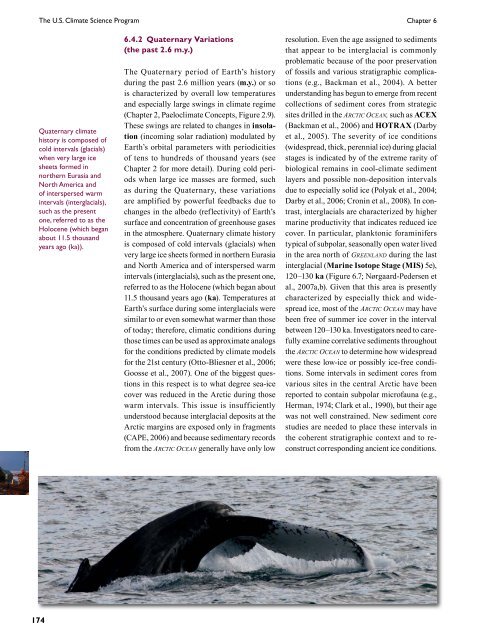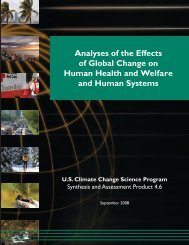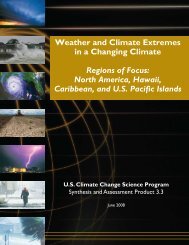Past Climate Variability and Change in the Arctic and at High Latitudes
Past Climate Variability and Change in the Arctic and at High Latitudes
Past Climate Variability and Change in the Arctic and at High Latitudes
Create successful ePaper yourself
Turn your PDF publications into a flip-book with our unique Google optimized e-Paper software.
174<br />
The U.S. <strong>Clim<strong>at</strong>e</strong> Science Program<br />
Qu<strong>at</strong>ernary clim<strong>at</strong>e<br />
history is composed of<br />
cold <strong>in</strong>tervals (glacials)<br />
when very large ice<br />
sheets formed <strong>in</strong><br />
nor<strong>the</strong>rn Eurasia <strong>and</strong><br />
North America <strong>and</strong><br />
of <strong>in</strong>terspersed warm<br />
<strong>in</strong>tervals (<strong>in</strong>terglacials),<br />
such as <strong>the</strong> present<br />
one, referred to as <strong>the</strong><br />
Holocene (which began<br />
about 11.5 thous<strong>and</strong><br />
years ago (ka)).<br />
6.4.2 Qu<strong>at</strong>ernary Vari<strong>at</strong>ions<br />
(<strong>the</strong> past 2.6 m.y.)<br />
The Qu<strong>at</strong>ernary period of Earth’s history<br />
dur<strong>in</strong>g <strong>the</strong> past 2.6 million years (m.y.) or so<br />
is characterized by overall low temper<strong>at</strong>ures<br />
<strong>and</strong> especially large sw<strong>in</strong>gs <strong>in</strong> clim<strong>at</strong>e regime<br />
(Chapter 2, Paeloclim<strong>at</strong>e Concepts, Figure 2.9).<br />
These sw<strong>in</strong>gs are rel<strong>at</strong>ed to changes <strong>in</strong> <strong>in</strong>sol<strong>at</strong>ion<br />
(<strong>in</strong>com<strong>in</strong>g solar radi<strong>at</strong>ion) modul<strong>at</strong>ed by<br />
Earth’s orbital parameters with periodicities<br />
of tens to hundreds of thous<strong>and</strong> years (see<br />
Chapter 2 for more detail). Dur<strong>in</strong>g cold periods<br />
when large ice masses are formed, such<br />
as dur<strong>in</strong>g <strong>the</strong> Qu<strong>at</strong>ernary, <strong>the</strong>se vari<strong>at</strong>ions<br />
are amplified by powerful feedbacks due to<br />
changes <strong>in</strong> <strong>the</strong> albedo (reflectivity) of Earth’s<br />
surface <strong>and</strong> concentr<strong>at</strong>ion of greenhouse gases<br />
<strong>in</strong> <strong>the</strong> <strong>at</strong>mosphere. Qu<strong>at</strong>ernary clim<strong>at</strong>e history<br />
is composed of cold <strong>in</strong>tervals (glacials) when<br />
very large ice sheets formed <strong>in</strong> nor<strong>the</strong>rn Eurasia<br />
<strong>and</strong> North America <strong>and</strong> of <strong>in</strong>terspersed warm<br />
<strong>in</strong>tervals (<strong>in</strong>terglacials), such as <strong>the</strong> present one,<br />
referred to as <strong>the</strong> Holocene (which began about<br />
11.5 thous<strong>and</strong> years ago (ka). Temper<strong>at</strong>ures <strong>at</strong><br />
Earth’s surface dur<strong>in</strong>g some <strong>in</strong>terglacials were<br />
similar to or even somewh<strong>at</strong> warmer than those<br />
of today; <strong>the</strong>refore, clim<strong>at</strong>ic conditions dur<strong>in</strong>g<br />
those times can be used as approxim<strong>at</strong>e analogs<br />
for <strong>the</strong> conditions predicted by clim<strong>at</strong>e models<br />
for <strong>the</strong> 21st century (Otto-Bliesner et al., 2006;<br />
Goosse et al., 2007). One of <strong>the</strong> biggest questions<br />
<strong>in</strong> this respect is to wh<strong>at</strong> degree sea-ice<br />
cover was reduced <strong>in</strong> <strong>the</strong> <strong>Arctic</strong> dur<strong>in</strong>g those<br />
warm <strong>in</strong>tervals. This issue is <strong>in</strong>sufficiently<br />
understood because <strong>in</strong>terglacial deposits <strong>at</strong> <strong>the</strong><br />
<strong>Arctic</strong> marg<strong>in</strong>s are exposed only <strong>in</strong> fragments<br />
(CAPE, 2006) <strong>and</strong> because sedimentary records<br />
from <strong>the</strong> <strong>Arctic</strong> oceAn generally have only low<br />
Chapter 6<br />
resolution. Even <strong>the</strong> age assigned to sediments<br />
th<strong>at</strong> appear to be <strong>in</strong>terglacial is commonly<br />
problem<strong>at</strong>ic because of <strong>the</strong> poor preserv<strong>at</strong>ion<br />
of fossils <strong>and</strong> various str<strong>at</strong>igraphic complic<strong>at</strong>ions<br />
(e.g., Backman et al., 2004). A better<br />
underst<strong>and</strong><strong>in</strong>g has begun to emerge from recent<br />
collections of sediment cores from str<strong>at</strong>egic<br />
sites drilled <strong>in</strong> <strong>the</strong> <strong>Arctic</strong> oceAn, such as ACEX<br />
(Backman et al., 2006) <strong>and</strong> HOTRAX (Darby<br />
et al., 2005). The severity of ice conditions<br />
(widespread, thick, perennial ice) dur<strong>in</strong>g glacial<br />
stages is <strong>in</strong>dic<strong>at</strong>ed by of <strong>the</strong> extreme rarity of<br />
biological rema<strong>in</strong>s <strong>in</strong> cool-clim<strong>at</strong>e sediment<br />
layers <strong>and</strong> possible non-deposition <strong>in</strong>tervals<br />
due to especially solid ice (Polyak et al., 2004;<br />
Darby et al., 2006; Cron<strong>in</strong> et al., 2008). In contrast,<br />
<strong>in</strong>terglacials are characterized by higher<br />
mar<strong>in</strong>e productivity th<strong>at</strong> <strong>in</strong>dic<strong>at</strong>es reduced ice<br />
cover. In particular, planktonic foram<strong>in</strong>ifers<br />
typical of subpolar, seasonally open w<strong>at</strong>er lived<br />
<strong>in</strong> <strong>the</strong> area north of GreenlAnd dur<strong>in</strong>g <strong>the</strong> last<br />
<strong>in</strong>terglacial (Mar<strong>in</strong>e Isotope Stage (MIS) 5e),<br />
120–130 ka (Figure 6.7; Nørgaard-Pedersen et<br />
al., 2007a,b). Given th<strong>at</strong> this area is presently<br />
characterized by especially thick <strong>and</strong> widespread<br />
ice, most of <strong>the</strong> <strong>Arctic</strong> oceAn may have<br />
been free of summer ice cover <strong>in</strong> <strong>the</strong> <strong>in</strong>terval<br />
between 120–130 ka. Investig<strong>at</strong>ors need to carefully<br />
exam<strong>in</strong>e correl<strong>at</strong>ive sediments throughout<br />
<strong>the</strong> <strong>Arctic</strong> oceAn to determ<strong>in</strong>e how widespread<br />
were <strong>the</strong>se low-ice or possibly ice-free conditions.<br />
Some <strong>in</strong>tervals <strong>in</strong> sediment cores from<br />
various sites <strong>in</strong> <strong>the</strong> central <strong>Arctic</strong> have been<br />
reported to conta<strong>in</strong> subpolar microfauna (e.g.,<br />
Herman, 1974; Clark et al., 1990), but <strong>the</strong>ir age<br />
was not well constra<strong>in</strong>ed. New sediment core<br />
studies are needed to place <strong>the</strong>se <strong>in</strong>tervals <strong>in</strong><br />
<strong>the</strong> coherent str<strong>at</strong>igraphic context <strong>and</strong> to reconstruct<br />
correspond<strong>in</strong>g ancient ice conditions.




